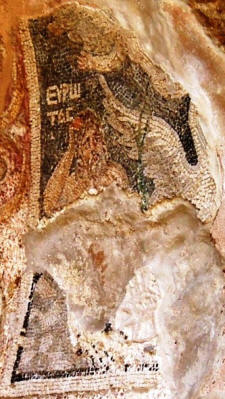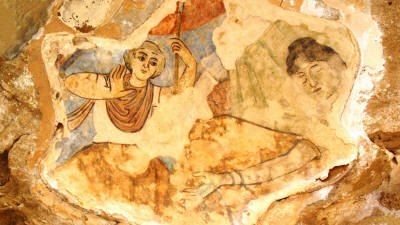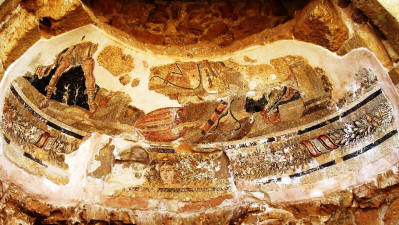The Roman Baths
Salamis, Near Famagusta, North Cyprus
 |
| Under Floor Heating |
The Roman baths can be found to the east of the Gymnasium complex, and should not be confused with the swimming pools at either end of the stoa. Like the Gymnasium, the structure was rebuilt in Byzantine times.
 |
| Swan Mosaic |
They were structures of grandeur, with a complex of marble-lined pools, fountains and hot and cold rooms.
The first part of the baths consisted of two octagonal cold rooms (frigidaria). These are found near the swimming pools. Between the cold rooms was the central sweating room (sudatorium), and here you can see the underfloor heating cavity. On the south wall of the sweating room, a fresco surviving from the 3rd century AD shows Hylas, the friend of Heracles who gets lost in Mysia on the way to Colchis to bring the Golden Fleece, as he refuses the water nymphs.
 |
| Hylas and the Water Nymphs |
The sweating room leads to the hot water bath (caldarium), which has been partially restored, and a dank, crypt-like cavity can be entered under its floor. You can see some mosaics here. A patch of abstracts and floral motifs is to be found in a niche of the north wall.
The baths were flanked by two more sweating rooms, where there are more mosaics. In the northern room, you can see one of three pomegranates on a branch.
 |
| Apollo and Artemis |
The best, and most complete fragments of all, however, are to be found in the southern bays of the southern sudatorium, where there are two. It is possible that this room was an alternative entrance to the bath complex.
One mosaic was originally thought to represent Leto's children Apollo and Artemis killing Niobe's children with arrows. The latter who has 14 children, belittles Leto for having only two. Some authorities, however, claim that this mosaic represents a battle between man and the Amazons.
The second mosaic shows Leda, the future mother of Helen, and Zeus, disguised as a swan with the river god Eurotas. Both of these mosaics are rare works from the end of the third or early 4th century AD, just before Christianity became the state religion.
See the location in Google maps.
Return to Salamis Index, or Famagusta Index.